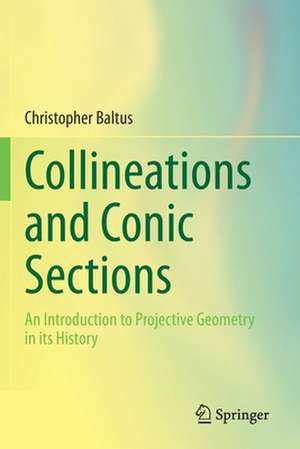Collineations and Conic Sections: An Introduction to Projective Geometry in its History
Autor Christopher Baltusen Limba Engleză Paperback – 2 sep 2021
- The Projective Plane and Central Collineations
- The Geometry of Euclid's Elements
- Conic Sections in Early Modern Europe
- Applications of Conics in History
With rare exception, the only prior knowledge required is a background in high school geometry. As a proof-based treatment, this monograph will be of interest to those who enjoy logical thinking, and could also be used in a geometry course that emphasizes projective geometry.
| Toate formatele și edițiile | Preț | Express |
|---|---|---|
| Paperback (1) | 382.57 lei 43-57 zile | |
| Springer International Publishing – 2 sep 2021 | 382.57 lei 43-57 zile | |
| Hardback (1) | 389.88 lei 43-57 zile | |
| Springer International Publishing – 2 sep 2020 | 389.88 lei 43-57 zile |
Preț: 382.57 lei
Nou
Puncte Express: 574
Preț estimativ în valută:
73.23€ • 79.57$ • 61.55£
73.23€ • 79.57$ • 61.55£
Carte tipărită la comandă
Livrare economică 21 aprilie-05 mai
Preluare comenzi: 021 569.72.76
Specificații
ISBN-13: 9783030462895
ISBN-10: 3030462897
Pagini: 187
Ilustrații: XI, 187 p.
Dimensiuni: 155 x 235 mm
Greutate: 0.29 kg
Ediția:1st ed. 2020
Editura: Springer International Publishing
Colecția Springer
Locul publicării:Cham, Switzerland
ISBN-10: 3030462897
Pagini: 187
Ilustrații: XI, 187 p.
Dimensiuni: 155 x 235 mm
Greutate: 0.29 kg
Ediția:1st ed. 2020
Editura: Springer International Publishing
Colecția Springer
Locul publicării:Cham, Switzerland
Cuprins
Preface.- 1. Introduction.- 2. Central Collineations.- 3. The Geometry of Euclid's Elements.- 4. Conics in Greek Geometry.- 5. Conic Sections in Early Modern Europe.- 6. Conic Sections in Early Modern Europe.- 7. Central Collineations.- 8. Nineteenth Century.- 9. Foci.- 10. Steiner. 11. Desargues and Involution.- 12. Looking Ahead.- 13. Matrices and Homogeneous Coordinates.- 14. Some Applications of Conics in History.- 15. Vertical Stretch and Isaac Newton's Conics.- 16. Three Appendices.- Bibliography.
Recenzii
“The text is organised into fiffteen chapters and deals with a wealth of classical topics. … The explicit exposition of all these topics is carried out in view of their history. The reader will find detailed information about Euclid's Elements and the treatment of conic sections by Greek mathematicians such as Apollonius of Perga and Archimedes.” (Hans Havlicek, Mathematical Reviews, April, 2022)
“This is a historically very well informed look at projective geometry, central collineations, and conics. The reader is exposed to both a wealth of results in projective geometry and to the motivations behind them … . The author has rendered a genuine service to the reader interested in this topic, as there is no contemporary book one could turn to both learn the basic techniques of projective geometry and to find out about its historical intricacies.” (Victor V. Pambuccian, zbMATH 1460.51001, 2021)
“This is a historically very well informed look at projective geometry, central collineations, and conics. The reader is exposed to both a wealth of results in projective geometry and to the motivations behind them … . The author has rendered a genuine service to the reader interested in this topic, as there is no contemporary book one could turn to both learn the basic techniques of projective geometry and to find out about its historical intricacies.” (Victor V. Pambuccian, zbMATH 1460.51001, 2021)
Textul de pe ultima copertă
This volume combines an introduction to central collineations with an introduction to projective geometry, set in its historical context and aiming to provide the reader with a general history through the middle of the nineteenth century. Topics covered include but are not limited to:
- The Projective Plane and Central Collineations
- The Geometry of Euclid's Elements
- Conic Sections in Early Modern Europe
- Applications of Conics in History
With rare exception, the only prior knowledge required is a background in high school geometry. As a proof-based treatment, this monograph will be of interest to those who enjoy logical thinking, and could also be used in a geometry course that emphasizes projective geometry.
Caracteristici
Gives the necessary geometry to readers of limited background Provides reader with a general history through the mid-nineteenth century Features a proof-based treatment
